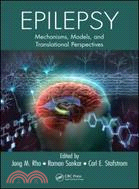Epilepsy: Mechanisms, Models, and Translational Perspectives
商品資訊
ISBN13:9781420085594
出版社:CRC Press UK
作者:Jong M. Rho (EDT); Raman Sankar (EDT); Carl E. Stafstrom (EDT)
出版日:2010/06/18
裝訂/頁數:精裝/684頁
定價
:NT$ 13975 元優惠價
:90 折 12578 元
若需訂購本書,請電洽客服 02-25006600[分機130、131]。
商品簡介
作者簡介
目次
相關商品
商品簡介
Epilepsy has afflicted humankind throughout recorded history; yet, it is only in the last half-century, that significant progress has been made in our basic understanding of the epileptic brain. Pivotal advances in drug development and surgical techniques, as well as the emergence of innovative approaches such as electrical stimulation of the nervous system, have led to a substantial reduction in the morbidity and mortality of patients with epilepsy. At the same time, remarkable developments in neuroscience have enhanced our understanding of brain structure and function.
Epilepsy: Mechanisms, Models, and Translational Perspectives incorporates new translational advances that bring epilepsy therapies from the laboratory bench to the bedside and back again. It brings together the work of more than 70 of the field’s most respected and cutting-edge researchers and clinicians. In 24 chapters, this extraordinarily comprehensive and current work:Offers an overview of the basic anatomic and functional substrates of seizure genesis and considers novel pathogenic concepts that have both emerged and been validated experimentally
Examines antiepileptic drug therapy, including the latest on molecular targets
Looks at the state of surgical treatments for epilepsy and discusses advances in the fields of structural and functional neuroimaging
Reviews the variety of nontraditional therapeutic options, such as the ketogenic diet, the vagus nerve stimulator, immunomodulators, neurosteroids, herbs, and botanicals
Investigates neuroendocrine, hormonal, and biobehavioral factors that influence seizure susceptibility—information that can be incorporated into the design of treatment algorithms on an individualized basis
Provides a glimpse of what future epilepsy therapies might look like, from novel mechanisms of drug delivery to gene and stem-cell therapies for epilepsy to seizure detection methods, to the ultimate goal of disease prevention.
The idea for this book was inspired by the editors’ collective desire to promote bridging of the so-called translational divide—that is, covering innovative treatment strategies based on scientific principles that have yet to be tested rigorously in the clinical setting, but yet may provide practitioners with new and promising approaches toward epilepsy therapeutics.
Epilepsy: Mechanisms, Models, and Translational Perspectives incorporates new translational advances that bring epilepsy therapies from the laboratory bench to the bedside and back again. It brings together the work of more than 70 of the field’s most respected and cutting-edge researchers and clinicians. In 24 chapters, this extraordinarily comprehensive and current work:Offers an overview of the basic anatomic and functional substrates of seizure genesis and considers novel pathogenic concepts that have both emerged and been validated experimentally
Examines antiepileptic drug therapy, including the latest on molecular targets
Looks at the state of surgical treatments for epilepsy and discusses advances in the fields of structural and functional neuroimaging
Reviews the variety of nontraditional therapeutic options, such as the ketogenic diet, the vagus nerve stimulator, immunomodulators, neurosteroids, herbs, and botanicals
Investigates neuroendocrine, hormonal, and biobehavioral factors that influence seizure susceptibility—information that can be incorporated into the design of treatment algorithms on an individualized basis
Provides a glimpse of what future epilepsy therapies might look like, from novel mechanisms of drug delivery to gene and stem-cell therapies for epilepsy to seizure detection methods, to the ultimate goal of disease prevention.
The idea for this book was inspired by the editors’ collective desire to promote bridging of the so-called translational divide—that is, covering innovative treatment strategies based on scientific principles that have yet to be tested rigorously in the clinical setting, but yet may provide practitioners with new and promising approaches toward epilepsy therapeutics.
作者簡介
Jong M. Rho, MD, is a senior staff scientist at the Barrow Neurological Institute and St. Joseph’s Hospital & Medical Center in Phoenix, Arizona. After obtaining an undergraduate degree in molecular biophysics and biochemistry at Yale University, Dr. Rho received his medical degree from the University of Cincinnati. Following a pediatric residency at the University of Southern California Children’s Hospital of Los Angeles and a neurology residency at the University of California, Los Angeles (UCLA), School of Medicine, he completed fellowships in pediatric neurology at the UCLA School of Medicine and in neuropharmacology at the National Institutes of Health (NIH). Dr. Rho’s main research interests are the mechanisms underlying the anticonvulsant and neuroprotective effects of the ketogenic diet, neuropharmacology of anticonvulsant compounds, and the study of surgically respected human epileptic tissue. His research activities have been sponsored by several NIH research grants, as well as a variety of intramural and extramural public and private sector sources. Dr. Rho has served on the editorial boards of Epilepsia and Epilepsy Currents and has been a regular reviewer for research grants submitted to the NIH. In addition to an extensive list of publications in basic science and pediatric neurology peer-reviewed journals, Dr. Rho has written numerous book chapters and edited several books and is a popular national and international guest lecturer.
Raman Sankar, MD, PhD, is a professor of neurology and pediatrics and chief of pediatric neurology at the David Geffen School of Medicine at UCLA. He holds the Rubin Brown Distinguished Chair in Pediatric Neurology. Dr. Sankar obtained his doctorate from the University of Washington in medicinal chemistry and was involved in teaching and research for several years prior to entering Tulane Medical School, where he obtained his medical degree. He trained in pediatrics at the Children’s Hospital of Los Angeles and completed his training in neurology and pediatric neurology at UCLA. His laboratory research pertains to mechanisms of seizure-induced injury and epileptogenicity in the developing brain and is funded by the National Institute of Neurological Disorders and Stroke (NINDS), National Institutes of Health (NIH). Current research includes investigations on improving the throughput for screening compounds for antiepileptogenic action on the developing brain and modeling the comorbidity of depression that accompanies epileptogenesis. He is one of the investigators in a NINDS-sponsored multicenter study on childhood absence epilepsy. Dr. Sankar is a reviewer for research grants submitted to the NIH, Epilepsy Foundation, CURE, American Epilepsy Society, and other organizations. He is a member of an active pediatric epilepsy program at UCLA that is well known internationally for many advances in pediatric epilepsy surgery. Dr. Sankar has authored more than 160 research articles, reviews, and book chapters and has served on the editorial boards of Epilepsia and Epilepsy Currents. Dr. Sankar serves on the professional advisory board of the Epilepsy Foundation. He is a member of the Commission on Neurobiology of the International League Against Epilepsy.
Carl E. Stafstrom, MD, PhD,is a professor of neurology and pediatrics and chief of the division of pediatric neurology at the University of Wisconsin Medical School. He received his AB from the University of Pennsylvania, followed by his MD and PhD degrees (the latter in physiology and biophysics) from the University of Washington, Seattle. After completing a residency in pediatrics at the University of Washington Children’s Hospital, Dr. Stafstrom trained in adult and pediatric neurology at Tufts–New England Medical Center in Boston, followed by fellowships in neurology research, epilepsy, and clinical neurophysiology at Children’s Hospital, Harvard Medical School. Dr. Stafstrom’s main research interests are the pathophysiological mechanisms of epilepsy in the developing brain, the consequences of seizures on cognition and behavior, and alternative epilepsy therapies such as the ketogenic diet. Dr. Stafstrom is the author of more than 150 publications on epilepsy and its mechanisms. He served as chair of the scientific review committee of Partnership for Epilepsy Research and is on the scientific advisory boards of the Epilepsy Foundation and the Charlie Foundation. He is the former chair of the Investigators’ Workshop Committee of the American Epilepsy Society. Dr. Stafstrom is associate editor of the journals Epilepsy Currents and Epilepsia. He places a high priority on the education of medical students and residents and is the recipient of numerous teaching awards.
Raman Sankar, MD, PhD, is a professor of neurology and pediatrics and chief of pediatric neurology at the David Geffen School of Medicine at UCLA. He holds the Rubin Brown Distinguished Chair in Pediatric Neurology. Dr. Sankar obtained his doctorate from the University of Washington in medicinal chemistry and was involved in teaching and research for several years prior to entering Tulane Medical School, where he obtained his medical degree. He trained in pediatrics at the Children’s Hospital of Los Angeles and completed his training in neurology and pediatric neurology at UCLA. His laboratory research pertains to mechanisms of seizure-induced injury and epileptogenicity in the developing brain and is funded by the National Institute of Neurological Disorders and Stroke (NINDS), National Institutes of Health (NIH). Current research includes investigations on improving the throughput for screening compounds for antiepileptogenic action on the developing brain and modeling the comorbidity of depression that accompanies epileptogenesis. He is one of the investigators in a NINDS-sponsored multicenter study on childhood absence epilepsy. Dr. Sankar is a reviewer for research grants submitted to the NIH, Epilepsy Foundation, CURE, American Epilepsy Society, and other organizations. He is a member of an active pediatric epilepsy program at UCLA that is well known internationally for many advances in pediatric epilepsy surgery. Dr. Sankar has authored more than 160 research articles, reviews, and book chapters and has served on the editorial boards of Epilepsia and Epilepsy Currents. Dr. Sankar serves on the professional advisory board of the Epilepsy Foundation. He is a member of the Commission on Neurobiology of the International League Against Epilepsy.
Carl E. Stafstrom, MD, PhD,is a professor of neurology and pediatrics and chief of the division of pediatric neurology at the University of Wisconsin Medical School. He received his AB from the University of Pennsylvania, followed by his MD and PhD degrees (the latter in physiology and biophysics) from the University of Washington, Seattle. After completing a residency in pediatrics at the University of Washington Children’s Hospital, Dr. Stafstrom trained in adult and pediatric neurology at Tufts–New England Medical Center in Boston, followed by fellowships in neurology research, epilepsy, and clinical neurophysiology at Children’s Hospital, Harvard Medical School. Dr. Stafstrom’s main research interests are the pathophysiological mechanisms of epilepsy in the developing brain, the consequences of seizures on cognition and behavior, and alternative epilepsy therapies such as the ketogenic diet. Dr. Stafstrom is the author of more than 150 publications on epilepsy and its mechanisms. He served as chair of the scientific review committee of Partnership for Epilepsy Research and is on the scientific advisory boards of the Epilepsy Foundation and the Charlie Foundation. He is the former chair of the Investigators’ Workshop Committee of the American Epilepsy Society. Dr. Stafstrom is associate editor of the journals Epilepsy Currents and Epilepsia. He places a high priority on the education of medical students and residents and is the recipient of numerous teaching awards.
目次
Section I Scientific FoundationsPathophysiological Mechanisms of Seizures and Epilepsy: A Primer, Carl E. StafstromBlood–Brain Barrier, Blood Flow, Neoplasms, and Epilepsy: The Role of Astrocytes, Luca Cucullo, Nicola Marchi, Vincent Fazio,Minh-Tri Nguyen, and Damir JanigroMetabolic Regulation of Seizures and Epileptogenesis, Manisha PatelBrain Inflammation and Epilepsy, Teresa Ravizza, Silvia Balosso, Eleonora Aronica, and Annamaria VezzaniDrug Resistance in Epilepsy and Status Epilepticus, Jaideep Kapur and Edward H. BertramEpilepsy with Complex Genetics: Looking Beyond the Channelopathies, Asuri N. Prasad and Chitra PrasadPathophysiology of Developmental Epilepsies, Judith L.Z. Weisenberg and Michael Wong
Section II Antiepileptic DrugsMechanisms of Antiepileptic Drug Action, Timothy A. SimeoneEpilepsy and Disease Modification: Animal Models for Novel Drug Discovery, H. Steve WhitePharmacogenetics of AED Development, Russell J Buono, Thomas N. Ferraro, Dennis J. Dlugos, and Karen S. WilcoxNeuroprotective Strategies Using Antiepileptic Drugs, Patrick G. Sullivan and Ryan D. ReadnowerPosttraumatic Seizures and Epileptogenesis: Good and Bad Plasticity, Christopher C. GizaPossible Roles of Nonsynaptic Mechanisms in Synchronization of Epileptic Seizures: Potential Antiepileptic Targets? F. Edward Dudek, Li-Rong Shao, and John E. RashA Mechanistic Approach to Antiepileptic Drug Interactions, Gail D. AndersonSection III Epilepsy SurgeryAdvances in Structural and Functional Neuroimaging: How Are These Guiding Epilepsy Surgery? Hyunmi Kim, A. LeBron Paige, and Robert C. KnowltonMagnetoencephalography in Clinical Epilepsy: A Translational Viewpoint, Jerry J. Shih and Michael P. WeisendWhat Have We Learned from Resective Surgery in Pediatric Patients with Cortical Dysplasia?, Carlos Cepeda and Gary W. MathernNonsurgical Ablation for Epilepsy, Erich O. Richter, Marina V. Abramova, William A. Friedman, and Steven N. RoperDeep Brain Stimulation for Epilepsy, Francisco Velasco, Ana Luisa Velasco, Luisa Rocha, Marcos Velasco, Jose D. Carrillo-Ruiz, Manoela Cuellar, Guillermo Castro, Fiacro Jimenez, and David TrejoOptical Imaging Techniques in Pediatric Neocortical Epilepsy, Daryl W. Hochman and Michael M. HaglundHigh-Frequency Oscillations in Epileptic Brain, S. Matt Stead, Mark Bower, and Greg WorrellSection IV Alternative TherapiesSpecial Treatments in Epilepsy, Kevin Chapman and James W. WhelessHerbs and Botanicals, Steven C. SchachterThe Ketogenic Diet: Scientific Principles Underlying Its Use, Kristopher J. Bough and Carl E. StafstromVagus Nerve Stimulation, Matthew M. Troester and Dean K. NaritokuAntiinflammatory Treatments for Seizure Syndromes and Epilepsy, Stéphane Auvin and Raman SankarSection V Other Modulators of the Epileptic StateImpact of Neuroendocrine Factors on Seizure Genesis and Treatment, Pavel Klein and Jaromir JanousekNeurosteroid Replacement Therapy for Catamenial Epilepsy, Doodipala S. Reddy and Michael A. RogawskiChronobiology and Sleep: Implications for Seizure Propensity, Mark QuiggPediatric Epilepsy: A Developmental Neuropsychiatric Disorder, Rochelle CaplanSection VI The Future of Epilepsy TherapyNovel Mechanisms of Drug Delivery, Vijay Ivaturi and James CloydEarly Seizure Detection: Considerations and Applications, Christophe C. Jouny, Piotr J. Franaszczuk, and Gregory K. BergeyGene and Stem Cell Therapies for Treating Epilepsy, Janice R. Naegele and Xu MaisanoArresting Epileptogenesis: The Current Challenge, Philip A. Schwartzkroin
Section II Antiepileptic DrugsMechanisms of Antiepileptic Drug Action, Timothy A. SimeoneEpilepsy and Disease Modification: Animal Models for Novel Drug Discovery, H. Steve WhitePharmacogenetics of AED Development, Russell J Buono, Thomas N. Ferraro, Dennis J. Dlugos, and Karen S. WilcoxNeuroprotective Strategies Using Antiepileptic Drugs, Patrick G. Sullivan and Ryan D. ReadnowerPosttraumatic Seizures and Epileptogenesis: Good and Bad Plasticity, Christopher C. GizaPossible Roles of Nonsynaptic Mechanisms in Synchronization of Epileptic Seizures: Potential Antiepileptic Targets? F. Edward Dudek, Li-Rong Shao, and John E. RashA Mechanistic Approach to Antiepileptic Drug Interactions, Gail D. AndersonSection III Epilepsy SurgeryAdvances in Structural and Functional Neuroimaging: How Are These Guiding Epilepsy Surgery? Hyunmi Kim, A. LeBron Paige, and Robert C. KnowltonMagnetoencephalography in Clinical Epilepsy: A Translational Viewpoint, Jerry J. Shih and Michael P. WeisendWhat Have We Learned from Resective Surgery in Pediatric Patients with Cortical Dysplasia?, Carlos Cepeda and Gary W. MathernNonsurgical Ablation for Epilepsy, Erich O. Richter, Marina V. Abramova, William A. Friedman, and Steven N. RoperDeep Brain Stimulation for Epilepsy, Francisco Velasco, Ana Luisa Velasco, Luisa Rocha, Marcos Velasco, Jose D. Carrillo-Ruiz, Manoela Cuellar, Guillermo Castro, Fiacro Jimenez, and David TrejoOptical Imaging Techniques in Pediatric Neocortical Epilepsy, Daryl W. Hochman and Michael M. HaglundHigh-Frequency Oscillations in Epileptic Brain, S. Matt Stead, Mark Bower, and Greg WorrellSection IV Alternative TherapiesSpecial Treatments in Epilepsy, Kevin Chapman and James W. WhelessHerbs and Botanicals, Steven C. SchachterThe Ketogenic Diet: Scientific Principles Underlying Its Use, Kristopher J. Bough and Carl E. StafstromVagus Nerve Stimulation, Matthew M. Troester and Dean K. NaritokuAntiinflammatory Treatments for Seizure Syndromes and Epilepsy, Stéphane Auvin and Raman SankarSection V Other Modulators of the Epileptic StateImpact of Neuroendocrine Factors on Seizure Genesis and Treatment, Pavel Klein and Jaromir JanousekNeurosteroid Replacement Therapy for Catamenial Epilepsy, Doodipala S. Reddy and Michael A. RogawskiChronobiology and Sleep: Implications for Seizure Propensity, Mark QuiggPediatric Epilepsy: A Developmental Neuropsychiatric Disorder, Rochelle CaplanSection VI The Future of Epilepsy TherapyNovel Mechanisms of Drug Delivery, Vijay Ivaturi and James CloydEarly Seizure Detection: Considerations and Applications, Christophe C. Jouny, Piotr J. Franaszczuk, and Gregory K. BergeyGene and Stem Cell Therapies for Treating Epilepsy, Janice R. Naegele and Xu MaisanoArresting Epileptogenesis: The Current Challenge, Philip A. Schwartzkroin
主題書展
更多
主題書展
更多書展今日66折
您曾經瀏覽過的商品
購物須知
外文書商品之書封,為出版社提供之樣本。實際出貨商品,以出版社所提供之現有版本為主。部份書籍,因出版社供應狀況特殊,匯率將依實際狀況做調整。
無庫存之商品,在您完成訂單程序之後,將以空運的方式為你下單調貨。為了縮短等待的時間,建議您將外文書與其他商品分開下單,以獲得最快的取貨速度,平均調貨時間為1~2個月。
為了保護您的權益,「三民網路書店」提供會員七日商品鑑賞期(收到商品為起始日)。
若要辦理退貨,請在商品鑑賞期內寄回,且商品必須是全新狀態與完整包裝(商品、附件、發票、隨貨贈品等)否則恕不接受退貨。
























